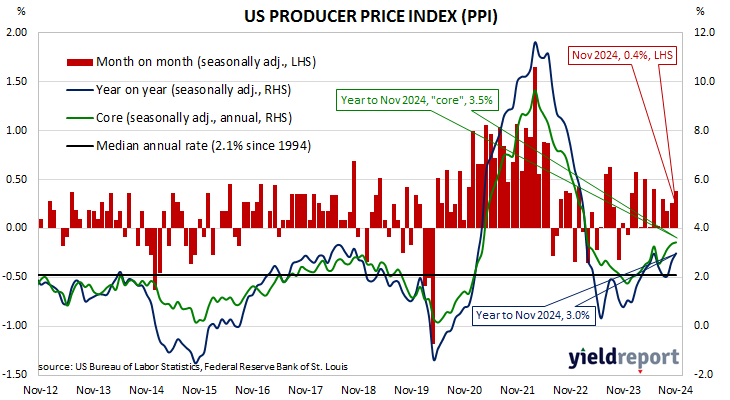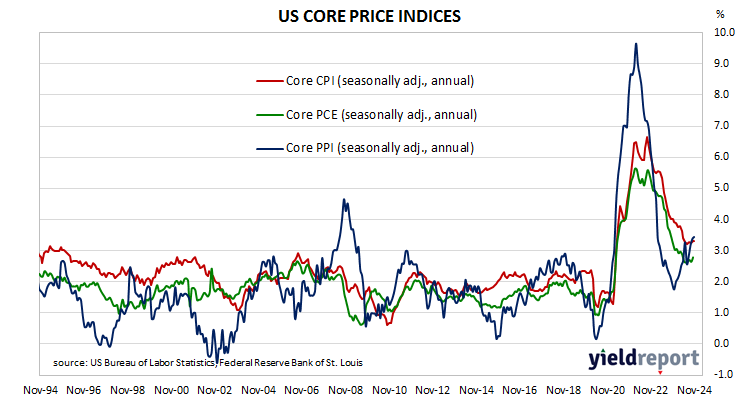Summary: US producer price index (PPI) up 0.4% in November, greater than expected; annual rate rises to 3.0%; “core” PPI up 0.2% over month, up 3.5% over year; ANZ: egg prices, profit margins a major driver; US Treasury yields rise; rate-cut expectations soften; services prices up 0.2%, goods prices up 0.7%.
Around the end of 2018, the annual inflation rate of the US producer price index (PPI) began a downtrend which continued through 2019. Months in which producer prices increased suggested the trend may have been coming to an end, only for it to continue, culminating in a plunge in April 2020. Figures returned to “normal” towards the end of that year but then moved well above the long-term average in 2021 and 2022 before falling back over 2023.
The latest figures published by the Bureau of Labor Statistics indicate producer prices increased by 0.4% in November after seasonal adjustments. The rise was greater than the 0.3% increase which had been generally expected as well as October’s increase of the same amount. On a 12-month basis, the rate of producer price inflation after seasonal adjustments accelerated from 2.6% to 3.0%.
Producer prices excluding foods and energy, or “core” PPI, rose by 0.2% after seasonal adjustments. The rise was in line with expectations but less than October’s 0.3% increase. The annual growth rate ticked up from 3.4% after revisions to 3.5%.
“The rise in the price of eggs accounted for 25% of the rise in final demand goods,” observed ANZ economist Jack Chambers. “Within final demand services, wholesaler and retailer margins rose 0.8% as outlets took advantage of the holiday season and buoyant consumers to push up margins.”
US Treasury bond yields rose on the day. By the close of business, the 2-year Treasury yield had added 4bps to 4.20%, the 10-year had gained 6bps to 4.33% while the 30-year yield finished 7bps higher at 4.55%.
In terms of US Fed policy, expectations of a lower federal funds rate in the next 12 months softened, although another three 25bp cuts are still currently priced in. At the close of business, contracts implied the effective federal funds rate would average 4.48% in December, 4.34% in January and 4.28% in February. November 2025 contracts implied 3.825%, 75bps less than the current rate.
“October PPI data showed a slight acceleration in price pressures but no imminent reversal of the disinflation process,” said ANZ economist Felix Ryan. “Together with the CPI data the day before, early estimates signal that October PCE data could be firm.”
The BLS stated the rise of the index was mostly attributable to a 0.3% increase in services prices. The final demand goods index rose by 0.1%.
The producer price index is a measure of prices received by producers for domestically produced goods, services and construction. It is put together in a fashion similar to the consumer price index (CPI) except it measures prices received from the producer’s perspective rather than from the perspective of a retailer or a consumer. It is another one of the various measures of inflation tracked by the US Fed, along with core personal consumption expenditure (PCE) price data.



